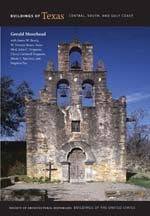
A landscaped plaza with an octagonal bandstand and concrete benches indicates, as in Hebbronville, the presence of Hispanic families at the founding of this rural community. At the north face of the square at 203 E. St. Rose of Lima Street, St. Rose of Lima Catholic Church (1940) is a crisply detailed neo-Romanesque building lacking sufficient scale to have a commanding presence in the plaza. The Francisco Vaello House (c. 1930), a side-gabled Craftsman residence at 127 E. St. Rose of Lima Street, displays Spanish Mediterranean influences and is linked to a nearly identical twin building on the 100 block of Railroad Avenue, also owned by the Vaello family. The Francisco Salinas Store (c. 1910) at Court and St. Rose of Lima streets is a well-preserved caliche-block dry goods store with a chamfered corner entrance. Without evidence of display windows, the store illustrates the persistence of traditional building types in Hispanic South Texas despite the arrival of the railroad.

